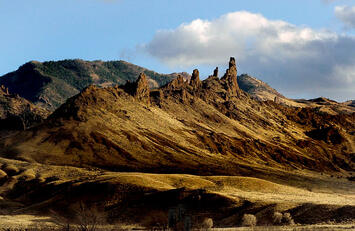
In 1981, Washington Post journalist Joel Garreau attempted to understand the many subcultures of America by examining in detail the differences between different states. He came away unsatisfied, and the ultimate result of this dissatisfaction was an influential book, The Nine Nations of North America. In it, he ignored these often-arbitrary state boundaries and divided America into nine regional “nations” that he argued corresponded more with cultural, socio-economic and demographic realities.
One of his nine “nations” of American he named The Empty Quarter.
Centered around the Rocky Mountains it extended out into adjacent and culturally and demographically similar territory. Garreau’s book was a minor sensation and, directly or indirectly, it launched several similar efforts over the ensuing decades — most recently Colin Woodard’s 2020 book American Nations: A History of the Eleven Rival Regional Cultures of North America. Woodard’s “Far West” nation in his book encompassed the core states of Garreau’s Empty Quarter while tweaking it with some of his own additions.
Surprisingly, as we begin to analyze the results of the 2020 Census, amidst an America rapidly dividing between struggling and thriving communities, The Empty Quarter emerges at the great American success story. Despite the sneers of the elite for whom it constitutes “flyover country,” the Empty Quarter represents the epitome of the inclusive growth the left claims to value.
For the purposes of this essay, I’ll define the modern Empty Quarter as a combination of the two nations outlined by Garreau and Woodard: Centered around the Rocky Mountains, the core Empty Quarter consists of Montana, Wyoming, Idaho, Northern Nevada, Utah, Eastern Oregon, Eastern Washington, and Northern Arizona. It also includes the entirety of the Dakotas, which politically, culturally, recreationally and demographically, particularly in their western regions, are far more similar to their Western neighbors in Montana and Wyoming than their Eastern counterparts in Minnesota and Iowa.
The new Empty Quarter region has four principal characteristics.
- It has been partially or completely governed by Republicans over the last decade. In states with mixed-party governance like Oregon and Washington, “Empty Quarter” areas in the East tend to be strongly right-leaning.
- It is far whiter than the country as a whole. Even the most diverse of these states, Colorado, is almost 20% whiter than the national average of 57.8%.
- It has substantial high-quality outdoor recreational activities in close proximity to population centers.
- It provides plenty of room to roam (Colorado, by some margin the densest of the areas studied, still has just 1/24th the population density of New Jersey).
Read the rest of this piece at Real Clear Policy.
Jeremy Carl is a Senior Fellow at the Claremont Institute. He lives with his family in the foothills of the Bridger Mountains, near Bozeman, MT.
Photo: Wyoming landscape by Bernard Spragg via Flickr in Public Domain.












